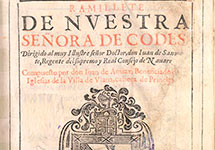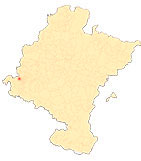Sanctuary of Nuestra Señora de Codés
By Pilar Andueza Unanua
Bouquet of Our Lady of Codés
Written by the presbyter Juan de Amiax, the Ramillete de Nuestra Señora de Codés was published in Pamplona in 1608 in the printing house of Carlos Labayen. This 384-page quarto Issue , with a two-color cover and woodcut illustrations, served during the 17th and 18th centuries to spread and propagate devotion to the Virgin of Codés.
The revitalization of the sanctuary after the nineteenth-century crisis brought with it new editions of the book, now adapting its content to a mentality far removed from baroque marvelousness. Eusebio de la Asunción, in 1905 saw the light in Corella, in the workshop of Manuel Gil, Historia de Nuestra Señora de Codés, written by D. Juan de Amiax, prebendary of Viana and arranged for the new edition by the Rev. Fr. Fr. Eusebio de la Asunción, and in 1933 the priest of Torralba Fernando Bujanda published in the printing house of Gumersindo Cerezo Historia del Santuario de Codés. I. Bouquet of Our Lady of Codés.
From the work of Amiax later authors drank later authors like the Jesuit father Juan de Villafañe, President of the Real high school of Salamanca and provincial of Old Castile, in his work Compendio Histórico en que se da noticia de las milagrosas, y devotas imagenes de la Reyna de Cielos, y Tierra, María Santissima, que se veneran en los más celebres santuarios de Hespaña, published in Salamanca in 1726 (with reedition in Madrid in 1940). Of the eighty-four most relevant Marian advocations of the country, he referred to four for Navarre: Our Lady of Roncesvalles, the Virgin of the Sagrario of the cathedral of Pamplona, Our Lady of Ujué and the one of Codés. The first three images were images of great devotion in the kingdom since the Middle Ages average, as demonstrated by the monarchs of Navarre. However, there is no record of the Virgin of Codés enjoying such fame at the same time. Possibly Villafañe picked it up because during the centuries of the Baroque, when he wrote his work, the fervor towards her was very evident not only among the Navarrese but also in the neighboring lands of La Rioja and Alava.
AMIAX, J. de, Ramillete de Nuestra Señora de Codés, Pamplona, By Carlos Labayen, 1608.
History of Our Lady of Codés. Sencillos apuntes sobre Codés, Logroño, Cofradía Administradora del Santuario de Nuestra Señora de Codés, 1939.
ANDUEZA UNANUA, P, "El Santuario de Nuestra Señora de Codés: historia, arte y devoción", in FELONES MORRÁS, R. (coord.), En montes y valles. Santuarios en Tierra Estella, Estella, Cofradías de Nuestra Señora del Puy, Nuestra Señora de Codés y San Gregorio Ostiense, 2017, pp. 52-65.
AZANZA LÓPEZ, J. J., Arquitectura religiosa del Barroco en Navarra, Pamplona, Institución Príncipe de Viana, 1998.
GARCÍA GAINZA, M. C. and others, Catalog Monumental de Navarra. Merindad de Estella II**, Pamplona, Institución Príncipe de Viana, 1983.
ITÚRBIDE DÍAS, J., Between the Renaissance and the Baroque: Ramillete de Nuestra Señora de Codés (A bouquet of Our Lady of Codés)Piece of the month. Chair de Patrimonio y Arte navarro, 2016.
ORDOÑEZ, V., Santuario de Codés, Colección Temas de Cultura Popular nº 343, Pamplona, Diputación Foral de Navarra, 1984.











